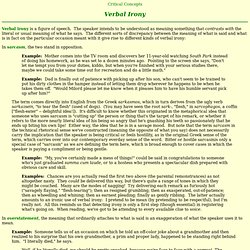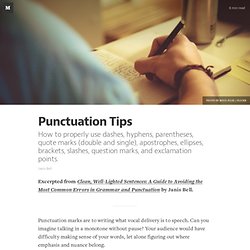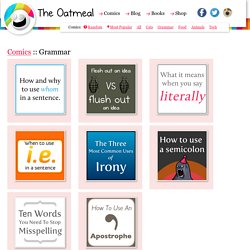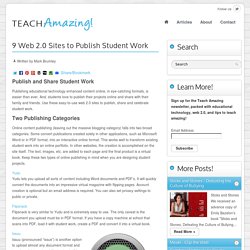

The 3 Most Common Uses of Irony. Examples of Irony. Irony pervades contemporary language.

From its use in sarcasm, comedy and just everyday conversation, irony has long transcended from only being a literary device. Irony can best be defined as that middle ground between what is said and what is meant, or others’ understanding of what was said and what was meant. It can sometimes be a bit confusing, yet at the same time it can also be amusing. Verbal Irony: Types. Critical Concepts Verbal Irony Verbal irony is a figure of speech.

The speaker intends to be understood as meaning something that contrasts with the literal or usual meaning of what he says. The different sorts of discrepancy between the meaning of what is said and what is in fact on the particular occasion meant with it give rise to different kinds of verbal irony: In sarcasm, the two stand in opposition. Example: Mother comes into the TV room and discovers her 11-year-old watching South Park instead of doing his homework, as he was set to a dozen minutes ago. The term comes directly into English from the Greek sarkasmos, which in turn derives from the ugly verb sarkazsein, "to tear the flesh" (used of dogs).
Situational Irony: Definition & Examples. Printing Press. Academic_verbs. English tests - Learn English - Online grammar tests, dictation tests, vocabulary tests, memory tests, daily test, and reading and comprehension tests. Learn English Free Test Your English How To Use This Page Here you will find English tests online to test your listening, memory, vocabulary, reading and comprehension, spelling and grammar skills.

Some of the tests will open up in a new browser window, when you have finished the game just close the window. Business English | Confusing words | Dictation | Gap Fill | Grammar | Memory Placement | Reading and Comprehension | Sorting and Matching | Spelling Tests | Vocabulary English Quizzes | English Games These tests have been developed to work best using Chrome, Firefox or IE. Business English Business English abbreviations test - How much do you know about abbreviations used in business? Job Titles - Do you know who does what in a company? Which department - Can you name the departments in a company? Confusing words Any vs Some Been vs Gone Borrow vs Lend By vs Until Check vs Control. Instant Grammar Check - Plagiarism Checker - Online Proofreader.
Daily Grammar - Improve your writing with our free grammar lessons. TeacherCopyright_chart-3. 10 reasons I love using Edmodo in my iPad classroom… Punctuation Tips. Punctuation marks are to writing what vocal delivery is to speech.

Can you imagine talking in a monotone without pause? Your audience would have difficulty making sense of your words, let alone figuring out where emphasis and nuance belong. If you drain the punctuation from your writing, you have no louds, no softs, no expression, no innuendo. If you use only a few punctuation marks, you seriously restrict your style. If you misuse punctuation marks, you send your reader down the wrong road, maybe even up a tree. You need to understand exactly what each mark can and cannot do, as well as the message it gives to your reader. Dashes First of all, a dash is not a hyphen.
Dashes do three jobs, each of which can be accomplished by another punctuation mark. 1. How To Use An Apostrophe. The Oatmeal - Comics. This is a grammar comic about the proper usage of who versus whom.

A look at the meaning of "flushing out an idea. " This comic will LITERALLY make butterflies explode out of your underpants. A guide explaining when to use i.e. instead of e.g. A little bit ironic, dontcha think? The most feared punctuation on earth. Lexicology. Hemingway. Character Development. 9 Web 2.0 Sites to Publish Student Work. Written by Mark Brumley Publish and Share Student Work Publishing educational technology enhanced content online, in eye-catching formats, is easier than ever.

And, students love to publish their projects online and share with their family and friends. Use these easy-to-use web 2.0 sites to publish, share and celebrate student work. Two Publishing Categories Online content publishing (leaving out the massive blogging category) falls into two broad categories. Yudu Yudu lets you upload all sorts of content including Word documents and PDF’s. Flipsnack Flipsnack is very similar to Yudu and is extremely easy to use. Issuu Issuu (pronounced “issue”) is another option to upload almost any document format and transform it into a virtual flipping book. Tools for Writing: Points of View in Writing. There are three different points of view that can be used in writing: first person, second person, and third person.

In academic writing, the third person point of view is usually clearer and allows a writer to come across as more credible. Due to this and other reasons, the third person point of view is considered the best in academic writing. First person occurs primarily through the use of the pronoun “I.” This is the point of view used when a writer is writing about himself. There may be times when it is okay to incorporate personal examples into an essay, and if so, the first person will be used. Second person involves the use of the pronoun “you” to refer to the reader.
Writer's_Improvement_List_byPaulGreenberg_2014 - Google Sheets. Avoiding Plagiarism. Quoting, Paraphrasing, and Summarizing. It's Here: A new look for the Purdue OWL!

The new version of the Purdue OWL is available at Worry not! Our navigation menu and content will remain largely the same. In 11 days, we will be discontinuing owl.english.purdue.edu and you will be automatically redirected to the new site. Summary: This handout is intended to help you become more comfortable with the uses of and distinctions among quotations, paraphrases, and summaries. Contributors:Dana Lynn Driscoll, Allen BrizeeLast Edited: 2013-02-15 09:44:45.